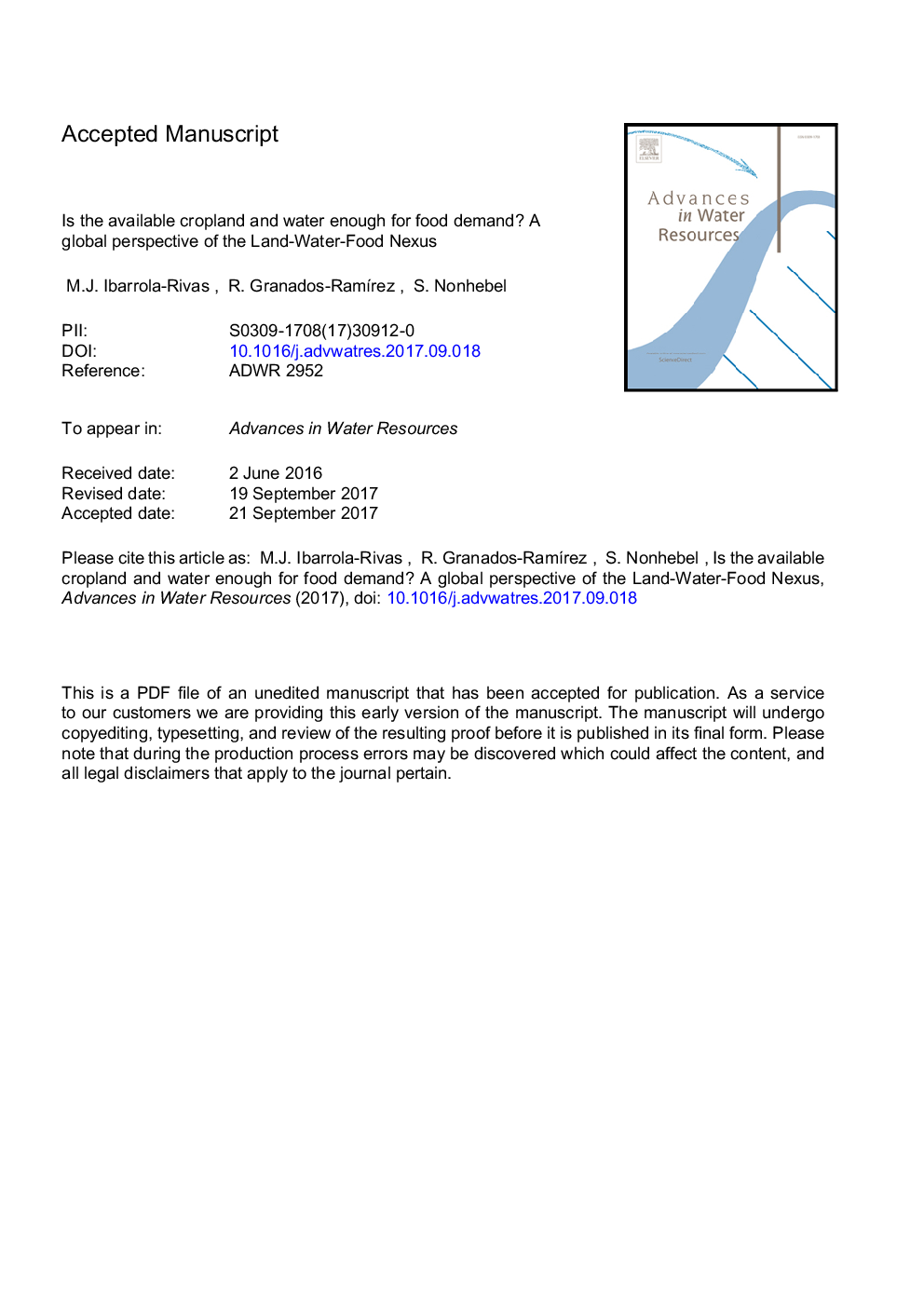| کد مقاله | کد نشریه | سال انتشار | مقاله انگلیسی | نسخه تمام متن |
|---|---|---|---|---|
| 8883430 | 1625601 | 2017 | 19 صفحه PDF | دانلود رایگان |
عنوان انگلیسی مقاله ISI
Is the available cropland and water enough for food demand? A global perspective of the Land-Water-Food nexus
ترجمه فارسی عنوان
آیا زمین های کشاورزی و آب مناسب برای تقاضای غذا وجود دارد؟ چشم انداز جهانی از رابطه آب و فاضلاب زمین
دانلود مقاله + سفارش ترجمه
دانلود مقاله ISI انگلیسی
رایگان برای ایرانیان
کلمات کلیدی
زمین و آب-مواد غذایی رابطه، تغییرات غذایی، تجزیه و تحلیل جهانی، باغچه منابع آبی، سناریوهای 2050،
ترجمه چکیده
زمین و آب منابع محلی ضروری برای تولید مواد غذایی هستند اما محدود هستند. رانندگان اصلی افزایش تقاضای غذا، رشد جمعیت و تغییرات غذایی هستند که بستگی به وضعیت اجتماعی و اقتصادی جمعیت دارد. این دو عامل بر دسترسی منابع محلی تاثیر می گذارد: رشد جمعیت زمین و آب را در هر فرد کاهش می دهد؛ و تصویب رژیم های پرجمعیت تقاضا برای زمین و آب را برای هر فرد افزایش می دهد. این مطالعه نشان می دهد که پتانسیل عرضه مواد غذایی جهانی با پیوند رانندگان تقاضای مواد غذایی با دسترسی زمین و آب ملی. این که آیا زمین و آب موجود برای رسیدگی به تقاضای غذای ملی کافی است برای 187 کشور محاسبه شده است. محاسبات برای وضعیت گذشته (1960 و 2010) و ارزیابی چهار سناریوی آینده (2050) برای بحث در مورد راه های مختلف رژیم غذایی، تعداد جمعیت و توسعه کشاورزی انجام شد. ورودی چشم انداز تقاضا در تجزیه و تحلیل چالش های مهمی را برای عرضه جهانی مواد غذایی آینده نسبت به سایر مطالعات نشان داده است. نتایج نشان می دهد که با کسب و کار به طور معمول ؟؟ سناریو، 40 درصد از جمعیت جهان در سال 2050 در کشورهایی زندگی خواهند کرد که زمین و آب کافی برای تامین نیاز جمعیتشان ندارند. محدودیت در رژیم های پایه موثر در کاهش محدودیت های زمین و آب خواهد بود. نتایج ما هر دو تولید مواد غذایی و عوامل تقاضای مواد غذایی را مشخص می کند و مناطقی که ممکن است در سال 2050 با شدت ترین چالش ها روبرو شوند.
موضوعات مرتبط
مهندسی و علوم پایه
علوم زمین و سیارات
فرآیندهای سطح زمین
چکیده انگلیسی
Land and water are essential local resources for food production but are limited. The main drivers of increasing food demand are population growth and dietary changes, which depend on the socioeconomic situation of the population. These two factors affect the availability of local resources: population growth reduces the land and water per person; and adoption of affluent diets increases the demand for land and water per person. This study shows potentials of global food supply by linking food demand drivers with national land and water availability. Whether the available land and water is enough to meet national food demand was calculated for 187 countries. The calculations were performed for the past situation (1960 and 2010) and to assess four future scenarios (2050) to discuss different paths of diets, population numbers and agricultural expansion. Inclusion of the demand perspective in the analysis has shown stronger challenges for future global food supply than have other studies. The results show that with the “business as usual” scenario, 40% of the global population in 2050 will live in countries with not enough land nor water to meet the demands of their population. Restriction to basic diets will be the most effective in lowering both land and water constraints. Our results identify both food production and food demand factors, and the regions that may experience the strongest challenges in 2050.
ناشر
Database: Elsevier - ScienceDirect (ساینس دایرکت)
Journal: Advances in Water Resources - Volume 110, December 2017, Pages 476-483
Journal: Advances in Water Resources - Volume 110, December 2017, Pages 476-483
نویسندگان
M.J. Ibarrola-Rivas, R. Granados-RamÃrez, S. Nonhebel,
